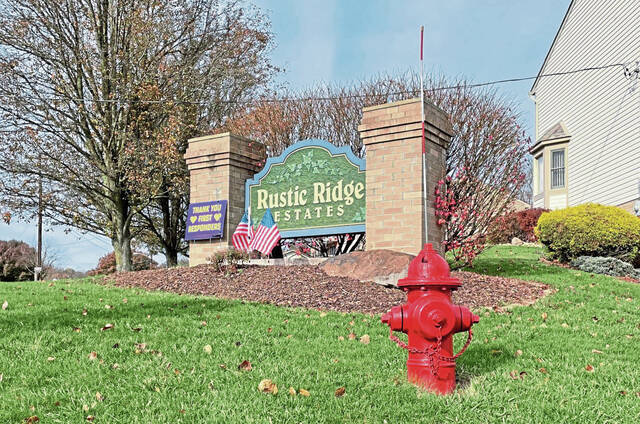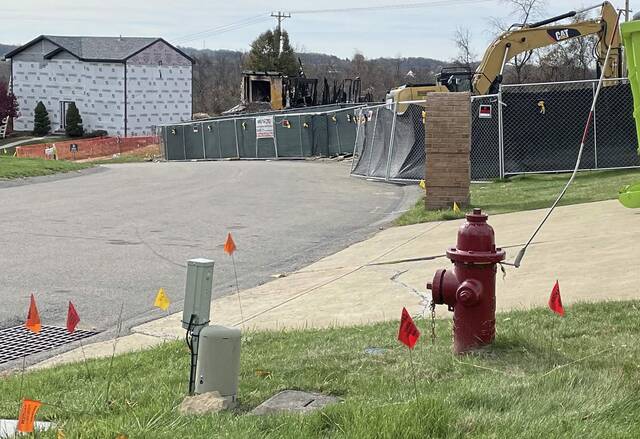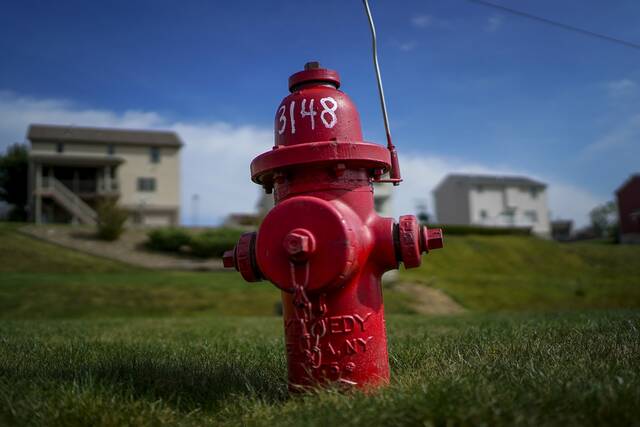Hydrant system where Plum house exploded not enough to fight fully engulfed house fire, Plum fire chief says
The fire hydrant system in the Rustic Ridge neighborhood of Plum, where a house explosion killed six people in August, is not adequate for fighting a single fully engulfed house fire, according to a borough fire chief who was on the scene that day.
“Due to the fire load, the gallons-per-minute (of water) were inadequate for the fire,” said Logans Ferry Heights Volunteer Fire Chief Steve Marsh.
Calculations by an Allegheny County Emergency Services Fire Academy administrator confirmed Marsh’s assessment. They show that rescue crews at the start were ill-equipped to battle the quickly spreading flames.
Marsh was one of the first emergency responders to arrive Aug. 12 — exactly three months ago — at Rustic Ridge Drive. He served as incident commander, overseeing firefighting operations and delegating tasks to leaders of other fire departments. Crews from more than 20 departments from multiple counties responded.
The explosion at 141 Rustic Ridge Drive resulted in an inferno that consumed the houses immediately to the left and right. All three homes were destroyed.
In the early moments after firefighters arrived, several could be heard complaining about what they described as an inadequate water supply.
Based on the size of the homes, fully engulfed structures at 141, 139 and 143 Rustic Ridge Drive would require at least 700 gallons of water per minute to be extinguished, said Glenn Kopec, administrator for the Allegheny County Emergency Services Fire Academy.
The Rustic Ridge hydrants are capable of producing up to 500 gallons per minute, said Plum Municipal Authority Chairman William Bonura.
According to the Allegheny County Real Estate website, the average size of a home in Rustic Ridge is 2,000 square feet, Marsh said.
That would mean the water flow from hydrants in the subdivision is incapable of saving one fully engulfed house there, based on a national standard taught by fire academies and accepted by most fire departments.
The system could handle a smaller house fire, Marsh said, or what he described as a “single room and contents event.”
“Basically a kitchen fire,” Marsh said. “(A fire in one location and) no other parts of the house is on fire.”
Fire crews at the explosion site employed a ladder truck to complement on-the-ground personnel. But the hose from the ladder truck often went limp because of low water flow or it failed to produce any water at all.
Firefighters called in tanker trucks from around the region. Portable dunk tanks were established about a quarter-mile from the explosion site.
The situation appeared so dire that fire crews could be heard discussing possibly tapping into nearby residential swimming pools. Jim Sims, fire chief at Holiday Park Volunteer Fire Department and Plum’s emergency management coordinator who also was on the scene that day, told reporters that afternoon that the tactic was not used.
Sims declined to comment for this story.
Multiple attempts to reach the chiefs at Renton and Unity volunteer fire departments, the other fire companies in the borough, were unsuccessful. Voicemail boxes were full at both departments, and multiple emails seeking comment went unreturned. Both firehouses were empty when a TribLIVE reporter stopped in an attempt to talk in person.
More water pressure flow at the start would have helped lessen property damage, Marsh said, but it would not have saved lives.
Paul and Heather Oravitz, Kevin Sebunia, Mike Thomas, and Casey and Keegan Clontz were killed as a result of the explosion.
The Oravitzes owned the home at 141 Rustic Ridge. Thomas lived at 139 Rustic Ridge. Sebunia and the Clontzes lived in homes a couple of houses away.
All six were inside the Oravitz home when it exploded.
In addition to the destroyed homes, 10 others were identified as possibly being structurally compromised by the explosion’s shock wave that moved through the community.
“This is the single largest event that I have been involved in,” said Marsh, a Plum firefighter for 10 years and a chief for six months. “It’s a very tragic event for the community and for the residents of Rustic Ridge, specifically.”
Investigators have not determined a cause of the explosion.
Housing plan system
The Rustic Ridge housing plan has 14 hydrants to serve about 200 homes. Each hydrant is capable of producing 500 gallons of water per minute, Plum Municipal Authority officials said.
On Aug. 12, firefighters used 6-inch and four or five 4-inch hoses as they attempted to pull between 1,500 and 2,000 gallons of water per minute, Bonura said at a recent authority meeting.
“It’s not a looped neighborhood,” Bonura said. “It’s one line in, one line out.
“The math just doesn’t work out. It’s weighed very heavily on everybody in this board that we were unable to take and supply that (necessary water).”
Crews initially tapped a hydrant below the homes. When they tapped a second hydrant on a hill above the homes, water flow dipped significantly, Marsh said.
A looped system would have more waterlines providing water to the system. That would produce less of a drop in water flow when more hydrants are tapped compared to a nonlooped system, Marsh said.
Municipal authority officials have said the water system and hydrants worked as designed that August morning.
Marsh did not dispute that.
“As it was designed,” he said, “the water system did function.”
Doing the math
Determining how much water flow is needed to extinguish a fire is complicated, Kopec said.
The National Fire Academy formula for determining necessary water amount is square footage of a structure divided by 3. The formula is taught in management tactical operations classes nationwide, Kopec said, and is a nationally accepted way firefighters calculate how many gallons per minute are necessary to adequately fight a fire.
“It’s an estimate,” Kopec said. “It gives us a ballpark as to what we need. It’s not foolproof.”
A building’s materials and what is burning are also factors, Kopec said.
“The water can only absorb so much heat,” he said. “If I’m not putting enough water on the amount of heat being created, it won’t (put out the fire).”
Marsh used the Allegheny County Real Estate website to look up the square footage of the three houses impacted by the explosion.
• 141 Rustic Ridge Drive was listed at 2,077 square feet. The National Fire Academy formula indicates 692 gallons per minute would be required to put out fully engulfed flames.
• 139 Rustic Ridge Drive was listed at 2,160 square feet, so 720 gallons per minute would be required.
• 143 Rustic Ridge Drive was listed at 2,146 square feet, so 715 gallons per minute would be required.
Firefighters also must be cognizant of nearby properties, Kopec said.
“You may need to add 25% of this calculated (gallons per minute) to protect any exposure(s),” Kopec said in an email to the Trib.
He described an exposure as any structure, or part of a structure, that measures more than 100 square feet and is within 50 feet of the burning building.
“The more gallons per minute I have, the quicker the fire will go out,” he said.
The size of the waterlines and hoses used to fight a fire also play a role.
The smaller either is, Kopec said, the more “water friction” there is — and potentially fewer gallons per minute pulled.
“You go to slurp up your milkshake and have a small straw, how hard is it going to be to get that milkshake into your mouth?” Kopec said. “The bigger (the hose) is, the easier the water can flow through it.”
Firefighters would need to take water from a pool, creek or other water source if they are not getting the flow they need from a public water system, Kopec said.
“Ultimately, it would be up to the (incident commander) to decide how best to handle the situation,” he said.
Possible changes
The Plum Municipal Authority is examining ways to “enhance the system” at Rustic Ridge, authority manager Howard Theis said.
One consideration: Changing the neighborhood hydrants to a looped system. Doing so would cost about $781,000 and require extending waterlines to the housing development, Theis said.
Nonlooped systems such as the one in Rustic Ridge are common throughout the state, Theis said. But there is more to changing a system than simply adding bigger pipes. The authority must consider service to homes and quality of drinking water, among other factors.
“It’s not all for flow,” Theis said.
The math of increasing pipe size also is not as simple as one might think. For example, Theis said, a 6-inch waterline holds 1.5 gallons per feet, while a 12-inch pipe holds 6 gallons per feet.
Theis declined to comment about whether Rustic Ridge’s current system functioned well enough to extinguish a fully engulfed home.
One change the authority is implementing is moving to a color-coded hydrant system that would allow firefighters to quickly know how many gallons per minute to expect from a hydrant.
Hydrant inspections and flushings are underway, Theis said. System data collection — measuring gallons per minute for each hydrant — is part of this year’s process.
The color coding follows that of the American Water Works Association, an international nonprofit dedicated, in part, to effective water management.
A blue hydrant indicates 1,500 gallons per minute or greater, green is 1,000 gpm or greater, yellow is 500 to 1,000 gpm, and red is less than 500 gpm.
“This is a great way visually for our firefighters to know what they have when they get on scene,” Marsh said. “We asked for it from (the authority) after Rustic Ridge.”
The authority manages 135 miles of waterlines, not including service lines to and from buildings. There are a little more than 600 hydrants throughout the borough.
Hydrant inspections may be completed in fall 2024, Theis said. He could not say when the color-coded system would be in place.
Mayor Harry Schlegel said he supports upgrades to Rustic Ridge’s system.
“If they are going to do that, I can’t see any downside to it,” he said. “They are the ones that are the experts on it.
“If the municipal authority feels that there is something they need to do to improve service over there, then they should do it.”
Rustic Ridge homeowners association president Greg Renko, who is an Allegheny County Police detective, was home at the time of the explosion. He was among the initial first responders at the scene and, with the help of a neighbor, carried Paul Oravitz from the rubble to safety.
Renko could not recall any conversations with borough or municipal authority officials about the water infrastructure before or after the explosion. But he said he would be in favor of scheduling a meeting.
“I would love to be able to sit down with them and brainstorm ideas,” he said. “I fully understand it’s not our position to make decisions (on how to change the system). But if we can help lend ideas, we as an association are open to any sort of communication with the municipality (and authority). That’s not just on this issue, on any topic.”
Something needs to change based on observations and talking with firefighters about the explosion response, Renko said.
“I don’t have any knowledge of the system or experience with it. But being present that day and watching the (firefighters) struggle to get water, and it was by no means (their) fault … for them to have to bring in so many tanker trucks from all over the region, that’s not good,” he said. “I think just by viewing it that day, if that’s the everyday system that day, it’s not feasible. It’s not going to work.”
Change made
In the wake of the water issues that firefighters encountered Aug. 12, Marsh said he has changed how his department responds to fires. A tanker will be dispatched to all structure fires in his coverage areas. That includes but is not limited to the Logans Ferry Heights, Ramparts and Barking areas and parts of Coxcomb Hill and Kerr roads.
His department’s run-cards — information used by Allegheny County Emergency Services’ dispatch center — were updated to have tankers dispatched to all fire calls, he said.
“Regardless of what the hydrant system is or does, the tankers will automatically be coming,” Marsh said.
He declined to comment about how other departments in Plum may have adjusted their responses to fire calls.
Michael DiVittorio is a TribLive reporter covering general news in Western Pennsylvania, with a penchant for festivals and food. He can be reached at mdivittorio@triblive.com.
Remove the ads from your TribLIVE reading experience but still support the journalists who create the content with TribLIVE Ad-Free.




